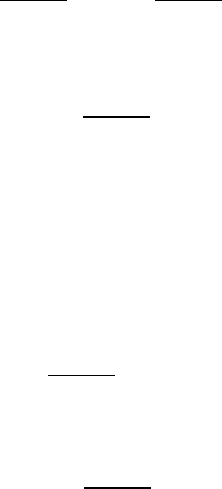Galdi G.P. An Introduction to the Mathematical Theory of the Navier-Stokes Equations: Steady-State Problems
Подождите немного. Документ загружается.


956 XIII Steady Navier–Stokes Flow in Domains with Unbounded Boundaries
(∇w, ∇ψ) = (U ·∇ψ, w) for all ψ ∈ D(Ω)
w ∈ D
1,2
0
(Ω).
(XIII.8.33)
Using the density property of D(Ω) into D
1,2
0
(Ω) along with Lemma X.2.1,
we may replace ψ with w in (XIII.8 .32) to derive
− |w|
1,2
= (U · ∇w, w). (XIII.8.34)
However, U is (weakly) divergence-free and, as a consequence,
(U · ∇w
r
, w
r
) = 0
along a sequence {w
r
} ⊂ D(Ω) approximating w in D
1,2
0
(Ω). Thus, again by
Lemma X.2.1, we obtain
(U · ∇w, w) = 0
and (XIII.8.32)
2
, (XIII.8.3 4) imply w ≡ 0 a.e. in Ω. From (XIII.8.2 4)
2
we
then find
w
m
→ 0 strongly in L
4q/(4−q)
(Ω
ρ
),
which contradicts (XIII.8.23). The vali dity of (XIII.8.20) is therefore estab-
lished and (XIII.8.19) furnishes that, fo r all k ∈ N, there exists a generalized
solution w
k
, π
k
to (XIII.8.10) satisfying the estimate
|w
k
|
1,2
+ kw
k
k
3q/(3−q)
+ |w
k
|
1,q
+ kπ
k
k
q
≤ c(hhv
∗
ii
1/2,2
+ hhv
∗
ii
1−1/q,q
)
(XIII.8.35)
with a constant c i ndependent of k. As a consequence, from {w
k
, π
k
} we can
select a subsequence, denoted a gain by {w
k
, π
k
}, and find a pair {w, π} obey-
ing the property (XIII.8.24). Taking into account (XIII.8.25 )
2
and reasoning
as we did to recover (XIII.8.32) we show that {w, π} is a generalized solution
to the problem
∆w = v ·∇w + ∇π
∇ · w = 0
)
in Ω
w = v
∗
at ∂Ω
(XIII.8.36)
such that
w ∈ D
1,q
(Ω) ∩ L
3q/(3−q)
(Ω) ∩ D
1,2
(Ω)
π ∈ L
q
(Ω).
(XIII.8.37)
However, v, p is also a generalized solution to (XIII.8.36) and by assumption,
(XIII.8.36), and (XIII.8.37) we conclude that the differences
w ≡ v − w, π = p − π
XIII.8 Aperture Domain: Summability Properti es of Generalized Solutions 957
solve the generalized form of (XIII.8.36) with v
∗
≡ 0. Since w ∈ D
1,2
0
(Ω),
reasoning as we did to show that (XIII.8.33) admits only the i dentically van-
ishing generalized solution, we prove w ≡ 0, π ≡ const. a.e. in Ω. We then
conclude that
v ∈ D
1,q
(Ω) ∩ L
3q/(3−q)
(Ω), for all q ∈ (6/5, 3/2]. (XIII.8.38)
Since 3q/(3 − q) (> 2) can be chosen as close to 2 as we pl ease by picking
q (> 6/5) suitably clo se to 6/5, and since
|v · ∇v|
−1,r
≤ kvk
2
2r
we may assert that
v · ∇v ∈ D
−1,q
0
(Ω) for all q ∈ (1, 3/2]
and, as a consequence, by Theorem V.3.3 it fo llows that
v ∈ D
1,q
(Ω) ∩ L
3q/(3−q)
(Ω) for all q ∈ (1, 3/2]. (XIII.8.39)
Since v ∈ D
1,q
(Ω), the lemma follows from (XIII.8.39) after application of
the interpol ation inequality (II.2.7). ut
Combining Lemma XIII.8.1, Theorem XIII.7.4, and Corollary XIII.7.1, we
obtain the (first part of the) following result concerning (global) summabil-
ity properties of generalized sol utions to problem (XIII.5.2) in the aperture
domain Ω.
Theorem XIII.8.1 Let the flux Φ satisfy the assumption of Theorem XIII.7.4.
Then any corresponding g eneralized solution v to (XIII.5.2) that obeys the
energy i nequality (XIII.6.6) enjoys the following summability properties:
v ∈ D
1,q
(Ω) ∩ L
3q/(3−q)
(Ω) for all q ∈ (1, 2].
Moreover, denoting by p the pressure field associated to v by Lemma XIII.5.1
we have
p − p
±
∈ L
s
(R
±
) for all s ∈ (1, 3],
where the constants p
±
are defined in Lemma XIII.5.1.
Proof. We have to show only the summability of p. However, since
v · ∇v ∈ D
−1,s
0
(Ω) for all s ∈ (1, 3],
the stated property follows at once from Theorem VI.5.1. ut

958 XIII Steady Navier–Stokes Flow in Domains with Unbounded Boundaries
XIII.9 Asymptotic Structure of Gener alize d Solutions
for Flow in an Aperture Domain
Using the results on the Stokes problem in the half-space as given in Theorem
IV.3. 2 and Theorem IV.3.3, it is a straightforward exercise to show that every
generalized solution to problem (XIII.5.2) satisfies the following asymptotic
properties
lim
|x|→∞
D
α
v(x) = 0
lim
|x|→∞,x∈R
3
±
D
α
(p(x) − p
±
) = 0,
(XIII.9.1)
for all |α| ≥ 0; cf. Exercise XIII.9.1. However, nothing can be said ab out the
order of decay, unless we put some suitable restriction on the magnitude of
the flux Φ of the velocity field through the aperture S. Actually, under the
hyp othesis of Theorem XIII.7.4, it is a relatively simple task to determine
the precise asymptotic structure of a ny corresponding generalized sol ution
v and of the associated pressure field p. In showing this, we shall follow an
approach entirely analogous to that employed in similar circumstances for flow
in exterior domains; cf. Section X.8 and X. 6.
First of all, we need a representation for v. By Theorem XI II.7.4, any
generalized solution corresponding to “small” Φ satisfies the condition
v
l
v
i
∈ L
2
(Ω), l, i = 1, 2, 3,
and so, by Lemma VI.5.1 , it follows that for all x ∈ R
3
±
v(x) admits the
representation
v
j
(x) = −
1
ν
Z
R
3
±
D
l
G
±
ij
(x, y)v
l
(y)v
i
(y)dy
−
Z
S
[v
i
(y)T
il
(G
±
j
, g
±
j
)(x, y)n
l
(y)dσ
y
,
(XIII.9.2)
where G
±
is the Green’s tensor for the Stokes problem in R
3
±
and g
±
is the
associated “pressure” field. Relation (XI II.9.2) is the starting point of our
asymptotic analysis. Since what we shall say equally applies to R
3
+
and R
3
−
,
to fix the i deas we shall deal with R
3
+
. Setting, for simplicity, G
+
= G and
g
+
= g, we begin to notice that from (XIII.9.2) we derive, in particular, for
all x ∈ R
3
+
v
j
(x) = −
1
ν
Z
R
3
+
D
l
G
ij
(x, y)v
l
(y)v
i
(y)dy + T
i3
(G
j
, g
j
)(x, 0)
Z
S
v
i
(y)dσ
y
−
Z
S
[T
il
(G
j
, g
j
)(x, y) −T
il
(G
j
, g
j
)(x, 0)] v
i
(y)n
l
(y)dσ
y
.

XIII.9 Aperture Domain: Asymptotic Structure of Generalized Solutions 959
Recalling the estimates (IV.3.50), from the latter relation, it follows for all
sufficiently large x ∈ R
3
+
that
v
j
(x) = −
1
ν
Z
R
3
+
D
l
G
ij
(x, y)v
l
(y)v
i
(y)dy + B
i
T
i3
(G
j
, g
j
)(x, 0) + ϕ
i
(x)
(XIII.9.3)
where
B
i
:=
Z
S
v
i
, ϕ
i
(x) = O(|x|
−3
). (XIII.9.4 )
Our next objective is to give an asymptotic estimate of the integral term in
(XIII.9.3). Specifically, we shall show that this term can be split as the sum of
two terms: the first is proportional to D
l
G
ij
(x, 0) and the second is O(|x|
−3+δ
),
for arbitrary positive δ. To reach this goal , we need some preliminary results.
For R > r > δ(S) and with the origin of coordinates in the interior of S, we
set
Ω
a
= R
3
+
∩ B
a
, a = r, R
Ω
r,R
= Ω
R
− Ω
r
Ω
a
= R
3
+
− Ω
a
a = r, R
and
G(R) =
Z
Ω
R
∇v : ∇v. (XIII.9.5)
We have the foll owing.
Lemma XIII.9.1 Let the assumptions of Theorem XIII.7.4 be satisfied.
Then the generalized solution v verifies
G(R) ≤ cR
−1
with c independent of R.
Proof. Without loss of generality, we set p
+
= 0. Multiply (XII I.5.2 )
1
by v,
integrate by parts over Ω
R,R
1
, R
1
> R, and use (XIII.5.2)
3
. We thus obtain
ν
Z
Ω
R,R
1
∇v : ∇v =
Z
∂B
R
∪∂B
R
1
νv ·
∂v
∂n
− pv · n −
v
2
2
v ·n
. (XIII.9.6)
Since, by Theorem XIII.7.4,
v ·
∂v
∂n
, pv, v
3
∈ L
1
(R
3
+
), (XIII.9.7)
letting R
1
→ ∞ along a suitable sequence into (XIII.9.6), we find
νG(R) =
Z
∂B
R
νv ·
∂v
∂n
−pv · n −
v
2
2
v · n
.

960 XIII Steady Navier–Stokes Flow in Domains with Unbounded Boundaries
In view of (XIII.9.7) we have
G ∈ L
1
(R, ∞), for all R > δ(S),
and since G
0
(R) < 0, the result follows from Lemma X.8 .1. ut
Lemma XIII.9.2 Let the assumptions of Theorem XIII.7.4 be fulfilled. Then
the generali zed solution v satisfies
v(x) = O(|x|
−1
), as |x| → ∞ i n R
3
+
.
Proof. Set |x| = 2R, for R > δ(S). From (XIII.9.3)–(XIII.9.4) and (IV.3.50)
it follows that
|v(x)| ≤ c
Z
Ω
R
v
2
(y)
|x − y|
2
dy +
Z
Ω
R
v
2
(y)
|x −y|
2
dy
+ O(|x|
−3
). (XIII.9.8)
Since, by Theorem XIII.7.4, v ∈ L
2
(Ω), we deduce
Z
Ω
R
v
2
(y)
|x − y|
2
dy ≤ c
1
|x|
−2
. (XIII.9.9)
Furthermore, let δ(S) < ρ/2 < ρ < R and let ψ
ρ
be a smooth function in R
3
with
ψ
ρ
(x) =
(
0 if |x| ≤ ρ/2
1 if |x| ≥ ρ.
Extending v(x) by zero for x ∈ R
3
−
and applying inequali ty (II. 6.20) to the
function ψ
ρ
(x)v(x), we obta in
Z
Ω
R
v
2
(y)
|x − y|
2
dy ≤ c
2
Z
Ω
R
∇v : ∇v
with c
2
independent of R. Thus, from (XIII.9.5) and Lemma XIII.9.1 we
deduce
Z
Ω
R
v
2
(y)
|x − y|
2
dy ≤ c
3
|x|
−1
and the lemma follows from this inequality, (XIII.9 .8), and (XIII.9.9). ut
Lemma XIII.9.3 Let the assumptions of Theorem XIII.7.4 be fulfilled. Then
the generali zed solution v satisfies
v(x) = O(|x|
−2
), as |x| → ∞ i n R
3
+
.

XIII.9 Aperture Domain: Asymptotic Structure of Generalized Solutions 961
Proof. From (XIII.9.3)–(XIII.9.4) and (IV.3.50) we see that it is enough to
show that for large |x| in R
3
+
N
j
(x) =
Z
R
3
+
D
l
G
ij
(x, y)v
l
(y)v
i
(y)dy = O(|x|
−2
) (XIII.9.10)
holds. From (IV.3.5 0) it follows, in parti cular, that
|D
α
G
ij
(x, y)| ≤
c
|x − y|
1+|α|
, 0 ≤ |α| ≤ 2, (XIII.9.11)
and so
|N(x)| ≤ c
Z
R
3
+
v
2
(y)
|x − y|
2
. (XII I .9.12)
We split the regi on of integration R
3
+
into three subregions Ω
R
, Ω
R,3R
, and
Ω
3R
, where R = |x|/2, and denote by I
1
, I
2
, and I
3
the three corresponding
integrals. Since
|x| ≤ 2 |x − y|, for y ∈ Ω
R
,
we find
I
1
≤
2c
|x|
2
Z
R
3
+
v
2
=
c
1
|x|
2
, (XII I .9.13)
where, in the last step, we have used the property v ∈ L
2
(Ω); cf. T heorem
XIII.7.4. Also,
|y| ≤ 3|x − y|, for y ∈ Ω
3R
,
and so
I
3
≤ 3c
Z
Ω
3R
v
2
(y)
|y|
2
.
Recalling that v ∈ L
2
(Ω), we conclude
I
3
≤
c
2
R
2
Z
Ω
v
2
=
c
3
|x|
2
. (XIII.9.14)
Concerning the estimate for I
2
, we have
I
2
=
Z
C
R
v
2
(y)
|x −y|
2
dy +
Z
B
1
(x)
v
2
(y)
|x −y|
2
dy, (XIII.9.15)
where
C
R
= Ω
R,3R
− B
1
(x).
By Lemma XIII.9.2,
v(x) = O(|x|
−1
) (XIII.9.16)
and so
Z
B
1
(x)
v
2
(y)
|x − y|
2
dy ≤
c
4
|x|
2
Z
B
1
(x)
dy
|x − y|
2
=
c
5
|x|
2
. (XIII.9. 17)

962 XIII Steady Navier–Stokes Flow in Domains with Unbounded Boundaries
Furthermore, again by (XIII.9.16), for any positive η we have
Z
C
R
v
2
(y)
|x −y|
2
dy ≤
c
5
|x|
3/2−η
Z
C
R
v
1/2+η
(y)
|x − y|
2
dy
and so, employing the H¨older inequality,
Z
C
R
v
2
(y)
|x −y|
2
dy ≤
c
5
|x|
3/2− η
Z
C
R
dy
|x − y|
2q
0
1/q
0
Z
Ω
v
(
1
2
+η)q
1/q
.
By Theorem XIII.7.4, it follows that v ∈ L
r
(Ω) for al l r > 3/2 and arbitrarily
close to 3/2. Therefore, the preceding inequality yields
Z
C
R
v
2
(y)
|x −y|
2
dy ≤
c
6
|x|
3/2−δ
(XIII.9.18)
where δ > 0 is arbitrarily close to zero. Collecting (XIII.9.10), (XIII.9.12)–
(XIII.9.15), (XIII.9.17), and (XIII.9.18), with the help of (XIII.9.3)–(XIII.9.3)
we derive
v(x) = O(|x|
−3/2+δ
). (XIII.9.19)
With this improved estimate on v we can give an i mproved estimate of the
first integral on the right-hand side of (XIII.9.15). Actually, from (XIII.9.19)
we find
Z
C
R
v
2
(y)
|x −y|
2
dy ≤
c
7
|x|
2
Z
C
R
v
(2−4δ)/ ( 3−2δ)
(y)
|x −y|
2
dy.
Thus, applying the H¨older inequal ity and recalling that v ∈ L
r
(Ω) for all
r ∈ (3/2, 6] we a rrive at
Z
C
R
v
2
(y)
|x −y|
2
≤
c
8
|x|
2
,
and the proof of the lemma is complete. ut
Lemma XIII.9.4 Let the assumptions of Theorem XIII.7.4 be fulfilled. Then
the generali zed solution v satisfies as |x| → ∞ in R
3
+
Z
R
3
+
[D
l
G
ij
(x, y) − D
l
G
ij
(x, 0)] v
l
(y)v
i
(y)dy = O(|x|
−3+δ
),
with δ an arbitrary small positive number.
Proof. We denote by I the integral we want to estimate and write
I =
Z
Ω
R
[D
l
G
ij
(x, y) − D
l
G
ij
(x, 0)]v
l
(y)v
i
(y)dy
+
Z
Ω
R
[D
l
G
ij
(x, y) − D
l
G
ij
(x, 0)] v
l
(y)v
i
(y)dy
≡ I
1
+ I
2
,
(XIII.9.20)

XIII.9 Aperture Domain: Asymptotic Structure of Generalized Solutions 963
where |x| = 2R. From the mean value theorem and (XIII.9.11) we deduce
|D
l
G
ij
(x, y) − D
l
G
ij
(x, 0)| = |y
l
D
k
D
l
G
ij
(x, βy)| ≤
c|y|
|x − βy|
3
, β ∈ (0, 1).
We have
|x| ≤ 2|x −βy|, y ∈ Ω
R
,
and so
|I
1
| ≤
8c
|x|
3
Z
Ω
R
v
2
(y)|y|dy.
From Lemma XIII.9.3 and the H¨older inequality we find
|I
1
| ≤
c
1
|x|
3
|Ω
R
|
1/q
0
kvk
3/2
3q/2,Ω
and since, by Theorem XIII.7.4, we can take q arbitrarily close to 1, we derive
|I
1
| ≤
c
2
|x|
3−δ
(XIII.9.21)
with δ > 0 arbitrarily close to zero. Moreover, from (XIII.9.1 1) it follows that
|I
2
| ≤
Z
Ω
R
|D
l
G
ij
(x, y)v
l
(y)v
i
(y)|dy + |D
l
G
ij
(x, 0)|
Z
Ω
R
v
2
(y)dy
≤ c
Z
Ω
R
v
2
(y)
|x −y|
2
dy +
1
|x|
2
Z
Ω
R
v
2
.
(XIII.9.22)
Therefore, using the estimate on v g iven in Lemma XIII.9.3 and then applying
Lemma I I.9.2, we infer that
Z
Ω
R
v
2
(y)
|x − y|
2
dy ≤
c
3
|x|
2
Z
R
3
dy
|x − y|
2
|y|
2
≤
c
4
|x|
3
. (XIII.9.23)
Likewise, again from Lemma XIII.9.3 and the property v ∈ L
r
(Ω) for all
r ∈ (3/2, 6], we find for any positive δ sufficiently close to zero
Z
Ω
R
v
2
(y)dy ≤
c
5
|x|
1−δ
Z
Ω
v
3/2+δ
=
c
6
|x|
1−δ
. (XIII.9.24)
The lemma then fol lows from (XIII.9.20)– (XIII. 9.24). ut
The representation (XIII.9.3)–(XIII.9.4), together with Lemma XIII.9.4,
allows us to show the fol lowing result concerning the asymptotic structure of
a generalized solution corresponding to a flux of suitably restricted size.
Theorem XIII.9.1 Let the flux Φ satisfy the assumption of Theorem XIII.7.4.
Then any corresponding generalized solution v to problem (XIII.5.2) that

964 XIII Steady Navier–Stokes Flow in Domains with Unbounded Boundaries
obeys the energy inequality (XIII.6.6) admits the foll owing asymptotic repre-
sentation as |x| → ∞, x ∈ R
3
±
:
v
j
(x) = A
±
il
D
l
G
±
ij
(x, 0) + B
±
i
T
i3
(G
±
j
, g
±
j
)(x, 0) + V
j
(x), j = 1, 2, 3.
(XIII.9.25)
Here G
±
≡ {G
±
ij
}, g
±
≡ {g
±
j
} is the Green’s tensor-solution for the Stokes
problem in R
3
±
(see (IV.3.46)-(IV.3.49)), G
±
j
≡ (G
±
1j
, G
±
2j
, G
±
3j
), and
A
±
il
:=
1
ν
Z
R
3
±
v
i
v
l
, B
±
i
:= ±
Z
S
v
i
, V
j
(x) = O(|x|
−3+δ
),
with δ an arbitrary positive number.
Remark XI II.9.1 From (XIII.9.25) and (IV.3 .50) we obtain the uni form
asymptotic estimate f or v (see also Lemma XIII.9.3):
v(x) = O(|x|
−2
).
Moreover, comparing (XIII.9.25) with the analogous formula (VI. 5.23) ob-
tained in the linear case, we recognize in (XIII.9.25) the presence of the extra
terms involving the qua ntities A
±
il
. Therefore, unlike the case of a n exterior
domain (when v
∞
6= 0), the nonlinearities give an explicit contribution to the
asymptotic expansion.
Remark XI II.9.2 Following the methods of Coscia & Patria (1992), one can
show that the first derivatives o f v obey the asymptotic estimate
D
k
v(x) = O(|x|
−3
), as |x| → ∞.
We shall not perform this study here; we refer the reader to Theorem 12 of
the paper by Coscia & Patria; cf. also Exercise XIII.9.2.
The final part of this section is devoted to the proo f of an asymptotic
representation for the pressure field p. As before, we shall show thi s in R
3
+
, an
analogous formula holding in R
3
−
. Let ϕ
R
(x) be a smooth function that equals
one for |x| ≥ 2R and zero for |x| ≤ R with |∇ϕ
R
| ≤ MR
−1
, M indep endent
of R. Setting
w = ϕ
R
v, τ = ϕ
R
(p − p
+
),
with p, p
+
introduced in Lemma XIII.5.1, we easily establish that w, τ satisfy
the following problem
ν∆w = ∇τ + F
∇ · w = g
)
in R
3
+
w = v at x
3
= 0
(XIII.9.26)
with
XIII.9 Aperture Domain: Asymptotic Structure of Generalized Solutions 965
F = 2 ∇ϕ
R
·∇v + ∆ϕ
R
v + ϕ
R
v · ∇v + (p −p
+
) · ∇ϕ
R
g = ∇ϕ
R
· v.
(XIII.9.27)
Denote, further, by h a solution to the non-homogeneous Stokes problem
ν∆h = ∇σ
∇ · h = −∇ϕ
R
· v
)
in R
3
+
h = 0 at x
3
= 0.
(XIII.9.28)
As we know from Theorem IV.3.2, this probl em admits a (unique) solution
satisfying the estimate
|h|
2,q
+ |σ|
1,q
≤ ck ∇ϕ
R
·vk
1,q
for a ll q > 1, (XIII.9.29)
with a constant c i ndependent of R. Using Theorem XIII.7 .4, together with
the properties of ϕ
R
, we easily show
lim
R→∞
kD
β
(∇ϕ
R
)D
χ
vk
q
= 0 for all q > 1, and |β|, | χ|=0,1. (XIII.9.30)
Choosing q = q
1
< 3 and modifying σ by the addition of an appropriate
constant, from Theorem II.6.3 we find
kσk
3q
1
/(3−q
1
)
≤ γ
1
|σ|
q
1
. (XIII.9.31)
Thus, from (XI II.9.29) and (XIII.9.31 ), with the help of Theorem II.9.1, we
find for all x ∈ R
3
+
|σ(x)| ≤ γ
2
(|σ|
1,q
1
+ |σ|
1,q
2
) q
2
> 3,
with γ
2
independent of R. From this relation, (XIII.9.29), and (XIII.9.30) we
then conclude
lim
R→∞
σ(x) = 0, for all x ∈ R
3
+
. (XIII.9.32)
Setting
u = w + h,
from (XIII.9.2 6)–(XIII.9.28) we find
ν∆u = ∇τ
1
+ F
∇ · u = 0
)
in R
3
+
u = v at x
3
= 0
(XIII.9.33)
with
τ
1
= τ + σ. (XIII.9.34)
